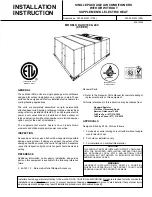
349215-JIM-B-1008
Johnson Controls Unitary Products
19
•
RH -
a 0-10 VDC analog input provided by a field-
installed return air relative humidity sensor for dual
enthalpy economizer configuration (used with OH).
•
IAQ -
a 0-10 VDC analog input provided by a field-
installed carbon dioxide sensor which monitors
indoor air quality (CO2 concentration) and enables
call for Demand Ventilation mode for units installed
with economizer option.
•
OAQ -
a 0-10 VDC analog input provided by a
field-installed carbon dioxide sensor which moni-
tors outdoor air quality (CO2 concentration) and,
along with IAQ, enables call for Differential
Demand Ventilation mode for units installed with
economizer option.
•
APS -
a 24 VAC binary input provided by a field-
installed air proving switch which monitors the
pressure difference across the indoor blower.
•
PUR -
a 24 VAC binary input for building purge
calls from an external source.
•
OCC -
a 24 VAC binary input used to set the build-
ing occupancy status for the control.
•
LIMIT 2 -
a 24 VAC binary input which either con-
firms 2nd-stage gas heat operation or receives an
error signal from the variable frequency drive.
Outputs:
•
FAN -
a 2-10 VDC analog output signal sent to the
VFD to modulate the speed of the indoor blower
motor.
•
ECON -
a 2-10 VDC analog output signal sent to
the economizer actuator to modulate position of
the return air and outdoor air dampers (optional).
•
EXH ~ -
a 24 VAC binary output signal used to turn
on/off the power exhaust relay (optional).
•
VAV BOX (gas/electric heat only) -
a normally
open relay contact connected to a terminal block,
used to drive the building's VAV boxes to full-open
during heating operation.
Programmable set points:
The
duct static set point
is the pressure that the drive
will maintain when operating the unit in VAV mode. The
set-point is adjustable between 0" WC and 5" WC with
the default setting of 1.5" WC.
The
duct static high-limit set point
is the maximum
allowable duct pressure to prevent damage from over-
pressurization of the ductwork in the event of either a
drive or damper failure. The high-limit set-point is
adjustable between 0" WC and 5" WC with the factory
default setting of 4.5" WC. If the duct static pressure
reaches the high-limit set point, then the supply fan
motor will be shutdown.
NOTE:
Either of the set points described above can be
changed through the unit control board (UCB)
with the use of a USB-to-RS485 converter,
personal computer or PDA
and a down-loaded
copy of the Simplicity® software available at
the UPGnet Commercial Product Catalog website.
FACTORY-INSTALLED VFD
The factory-installed VFD is mounted in the Blower
Access Compartment above the blower assembly. The
drive comes wired from the factory to include both 3-
phase power and control connections (run permit sig-
nal, speed reference signal & fault signal).
All required drive parameters are pre-programmed at
the factory, except in the case of 208-volt applications,
in which the parameter that defines motor nameplate
voltage must be changed to a value of 208.00 and the
parameter that defines motor-rated current must be
changed to the appropriate value appearing on the
motor's nameplate. Refer to the enclosed drive material
or access the UPGnet Commercial Product Catalog
website for instructions on changing parameter settings.
For units also equipped with gas/electric heat, a termi-
nal block located in the unit's control box and con-
nected to the VAV board's "VAV BOX" terminal, must
be field wired to the building's VAV boxes to ensure
fully open dampers during heating operation.
MANUAL BYPASS
An optional, factory-installed manual bypass switch
available with factory-installed VFD can be found in the
Blower Motor Access compartment and has the follow-
ing three positions:
•
DRIVE
- routes power through the VFD for modu-
lating control of the indoor blower motor.
•
LINE
(or BYPASS) - routes power directly to the
motor which provides full-speed motor operation
and complete electrical isolation of the drive.
•
TEST
- routes power to the VFD but not to the
motor to allow for drive programming and/or diag-
nostics.
The customer must be aware of the duct pres-
sure design limit, and what the duct pressure
sensor is reading when the peak pressure is
reached (ie the pressure transducer sensing
tube may not be located at the place of highest
pressure in the system).
















































